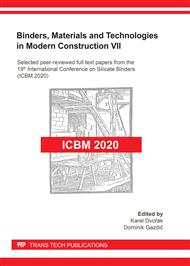[1]
Y. Sumi, Mathematical and Computational Analyses of Cracking Formation, Springer, Tokyo, (2014).
Google Scholar
[2]
J. Vala, Structure identification of metal fibre reinforced cementitious composites, Algoritmy – 20th Conference on Scientific Computing in Podbanské (Slovak Rep., 2016), Proceedings, STU Bratislava, 2016, p.244–253.
Google Scholar
[3]
A.C. Eringen, Nonlocal Continuum Field Theories, Springer, New York, (2002).
Google Scholar
[4]
M. Jirásek, Damage and smeared crack models, in: Numerical Modeling of Concrete Cracking (G. Hofstetter and G. Meschke, eds), Springer: CISM International Centre for Mechanical Sciences 532, Udine, 2011, p.1–49.
DOI: 10.1007/978-3-7091-0897-0_1
Google Scholar
[5]
C. Giry, F. Dufour, J. Mazars, Stress-based nonlocal damage model, Int. J. Solids Struct. 48 (2011) 3431–3443.
DOI: 10.1016/j.ijsolstr.2011.08.012
Google Scholar
[6]
X. Li, J. Chen, An extensive cohesive damage model for simulation arbitrary damage propagation in engineering materials, Comput. Methods Appl. Mech. Eng. 315 (2017) 744–759.
DOI: 10.1016/j.cma.2016.11.029
Google Scholar
[7]
V. Kozák, Z. Chlup, P. Padělek, I. Dlouhý, Prediction of the traction separation law of ceramics using iterative finite element modelling, Solid State Phenomena 258 (2017) 186–189.
DOI: 10.4028/www.scientific.net/ssp.258.186
Google Scholar
[8]
K.-J.Bathe, G. Noh, Insight into an implicit time integration scheme for structural dynamics, Comput. Struct. 98-99 (2012) 1–6.
DOI: 10.1016/j.compstruc.2012.01.009
Google Scholar
[9]
G. Noh, K.-J.Bathe, Further insights into an implicit time integration scheme for structural dynamics, Comput. Struct. 202 (2018), 15–24.
DOI: 10.1016/j.compstruc.2018.02.007
Google Scholar
[10]
A.R. Khoei, Extended Finite Element Method: Theory and Applications, J. Wiley & Sons, (2015).
Google Scholar
[11]
R.F. Swati, L.H. Wen, H. Elahi, A.A. Khan, S. Shad, Extended finite element method (XFEM) analysis of fiber reinforced composites for prediction of micro-crack propagation and delaminations in progressive damage: a review, Microsyst. Technol. 25 (2019) 747–763.
DOI: 10.1007/s00542-018-4021-0
Google Scholar
[12]
M. Jedlička, V. Rek, J. Vala, on automation of XFEM computations considering general shapes of cracks in terms of the stress analysis of spatial structures, Structural Integrity Procedia 23 (2019) 445–450.
DOI: 10.1016/j.prostr.2020.01.127
Google Scholar
[13]
J. Vala, V. Kozák, Computational analysis of quasi-brittle fracture in fibre reinforced cementitious composites, Theor. Appl. Fract. Mech. 107 (2020) 102486/1–8.
DOI: 10.1016/j.tafmec.2020.102486
Google Scholar
[14]
J. Vala, V. Kozák, Nonlocal damage modelling of quasi-brittle composites, Appl. Math., sub-mitted, 20 pp.
Google Scholar


